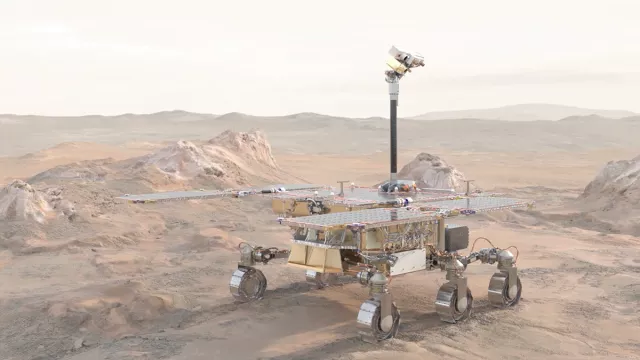ExoMars 2022, the second mission of the ExoMars programme, was suspended by ESA on 17 March 2022 and its scheduled September 2022 launch from the Baikonur Cosmodrome cancelled.
In March 2023, NASA rejoined the project and the Rosalind Franklin Mission (RFM) is now planned to launch in October 2028 and land on Mars end November 2030.
Key information
Key figures
- 310 kg: rover mass
- 8 instruments on rover
- 3.5 x 2 x 2 m: rover dimensions
- 6 contributing French laboratories and universities
Key milestones
- November 2030: Landing of Rosalind Franklin rover on Mars
- October 2028: Launch of Rosalind Franklin rover
- March 2023: NASA rejoins project
- End 2022: Project resumed by ESA without Roscosmos
- 17 March 2022: Project suspended by ESA for geopolitical reasons
- 9 November 2018: Oxia Planum selected as rover landing site for second ExoMars mission
- 19 October 2016: TGO captured into Mars orbit and failed landing attempt by Schiaparelli module
- 14 March 2016: Launch of TGO (ExoMars 2016) by Proton
- December 2011: NASA withdraws from ExoMars programme and ESA partners with Roscosmos
- July 2010: Orbiter for first ExoMars mission named Trace Gas Orbiter (TGO)
- October 2009: NASA joins project
- October 1999: Start of ExoMars project
Project in brief
The ExoMars programme takes its name from the field of ‘exobiology’, the science that seeks to detect traces of extraterrestrial lifeforms, and its target planet, Mars. ExoMars was initially pursued in partnership with Roscosmos, the Russian federal space agency, and then with NASA after relations with Roscosmos were suspended in 2022, and comprises two missions.
The first mission, ExoMars 2016, was launched from the Baikonur Cosmodrome on 14 March 2016. On 19 October 2016, the Trace Gas Orbiter (TGO) satellite was inserted into Mars orbit. After a long aerobraking phase, science operations began in April 2018 and are still ongoing. TGO is studying the planet’s atmosphere and evolution, looking for trace gases like methane possibly generated by biological processes. It also serves as a platform to relay telecommunications to Earth for surface operations, notably for the Perseverance rover on NASA’s Mars 2020 mission.
Just before insertion into Mars orbit, TGO released an entry, descent and landing demonstrator module (EDM) that descended by parachute for a planned soft landing on the planet’s surface. ESA named this module Schiaparelli after the Italian astronomer who famously mapped Mars’ surface features in the 19th century. One of the module’s sensors became saturated during the descent, leading to the landing sequence being interrupted while it was still some 4,000 metres from the surface. The demonstrator nevertheless continued transmitting until impact and data from all sensors were collected and relayed back to Earth for processing and analysis.
The second mission, ExoMars 2028, named RFM (Rosalind Franklin Mission) by ESA and NASA, will land the European Rosalind Franklin rover on Mars. The rover is named in honour of Rosalind Franklin, a young British scientist who made a crucial contribution to the discovery of the double-helix structure of DNA and died young in 1958. The 310-kilogram rover will have eight scientific instruments to study the soil and subsoil. Able to drill to a depth of two metres, it will collect and analyse samples inside its built-in ultraclean and sterile laboratory that have not been exposed to the radiation and oxidizers that would otherwise destroy organic materials.
CNES’s role
CNES and French research laboratories are contributing a number of instruments:
On the Rosalind Franklin rover:
- MicrOmega, a hyperspectral microscope developed by the IAS space astrophysics institute as PI, in partnership with the University of Bern
- WISDOM, a ground-penetrating radar (GPR) developed by the LATMOS atmospheres, environments and space observations laboratory as PI, in partnership with the Dresden University of Technology (TU Dresden)
- The gas chromatograph (GC) for the MOMA instrument (Mars Organic Molecule Analyser, a mass spectrometer combined with a gas chromatograph and a laser-desorption channel) developed by the LISA inter-university laboratory for the study of atmospheric systems as Co-I, in partnership with the Max Planck Institute (MPS) in Gottingen (PI) and NASA’s Goddard Space Flight Center (GSFC)
- The DC/DC board for the RLS instrument (Raman Spectrometer), construction and integration of the ICEU (Instrument Control and Excitation Unit) by the IRAP astrophysics and planetology research institute as Co-I, in partnership with INTA/Valladolid University (PI) and Rutherford Appleton Laboratory (RAL, UK)
- Encapsulation and testing of the CLUPI instrument (CLose-UP Imager), under the responsibility of the CBM molecular biology centre and the CEMHTI extreme conditions and materials - high temperature and irradiation unit, as Co-I, in partnership with the Space Exploration Institute (SEI), Neuchâtel (Switzerland, (PI)
- Autonomous navigation software for the rover, developed by CNES
On the descent module: three narrow-band infrared radiometers (ICOTOM), embedded in the French-German COMARS+ experiment under a partnership between CNES and DLR, overseen by Germany.
On Martian climate research: funding for updates to the MCD (Mars Climate Database), under the responsibility of the LMD dynamic meteorology research laboratory.
Contacts
Project Lead for French contribution to ExoMars
André Debus
E-mail: andre.debus at cnes.fr
Project Quality Assurance Manager
Xavier Penou
E-mail: xavier.penou at cnes.fr
Exobiology, Exoplanets and Planetary Protection subject matter expert
Christian Mustin
E-mail: christian.mustin at cnes.fr


